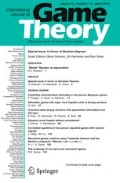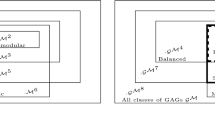Abstract
A transferable utility (TU) game with n players specifies a vector of \(2^n-1\) real numbers, i.e. a number for each non-empty coalition, and this can be difficult to handle for large n. Therefore, several models from the literature focus on interaction situations which are characterized by a compact representation of a TU-game, and such that the worth of each coalition can be easily computed. Sometimes, the worth of each coalition is computed from the values of single players by means of a mechanism describing how the individual abilities interact within groups of players. In this paper we introduce the class of Generalized additive games (GAGs), where the worth of a coalition \(S { \subseteq } N\) is evaluated by means of an interaction filter, that is a map \(\mathcal {M}\) which returns the valuable players involved in the cooperation among players in S. Moreover, we investigate the subclass of basic GAGs, where the filter \(\mathcal {M}\) selects, for each coalition S, those players that have friends but not enemies in S. We show that well-known classes of TU-games can be represented in terms of such basic GAGs, and we investigate the problem of computing the core and the semivalues for specific families of GAGs.
Similar content being viewed by others
Notes
Note that all the previous definitions hold for TU-games where v represents a gain, while the inequalities should be replaced with \(\le \) when v is a cost function.
Since the graph is undirected, we assume by convention that, if an edge between i and j is present, \(w_{i,j} \ne 0\) and \(w_{j,i}=0\) for \(i < j\).
References
Aadithya KV, Ravindran B, Michalak TP, Jennings NR (2010) Efficient computation of the Shapley value for centrality in networks. International Workshop on Internet and Network Economics. Springer, Berlin, Heidelberg, pp 1–13
Amer R, Giménez JM (2004) A connectivity game for graphs. Math Methods Oper Res 60(3):453–470
Aumann RJ, Maschler M (1985) Game theoretic analysis of a bankruptcy problem from the Talmud. J Econ Theory 36(2):195–213
Banzhaf JF III (1964) Weighted voting doesn’t work: a mathematical analysis. Rutgers L Rev 19:317
Bondareva O (1962) The theory of the core in an n-person game. Vestnik Leningr Univ 13:141–142
Bonzon E, Maudet N, Moretti S (2014) Coalitional games for abstract argumentation. In: Proceedings of the 5th International Conference on Computational Models of Argument (COMMA’14), pp 161–172
Borm P, Hamers H, Hendrickx R (2001) Operations research games: a survey. Top 9(2):139–199
Brânzei R, Fragnelli V, Tijs S (2002) Tree-connected peer group situations and peer group games. Math Methods Oper Res 55(1):93–106
Chalkiadakis G, Elkind E, Wooldridge M (2011) Computational aspects of cooperative game theory. Synth Lect Artif Intell Mach Learn 5(6):1–168
Curiel I, Potters J, Prasad R, Tijs S, Veltman B (1993) Cooperation in one machine scheduling. Zeitschrift für Oper Res 38(2):113–129
Curiel I, Hamers H, Tijs S, Potters J (1997) Restricted component additive games. Math Methods Oper Res 45(2):213–220
Deng X, Papadimitriou CH (1994) On the complexity of cooperative solution concepts. Math Oper Res 19(2):257–266
Dimitrov D, Borm P, Hendrickx R, Sung SC (2006) Simple priorities and core stability in hedonic games. Soc Choice Welf 26(2):421–433
Dubey P, Neyman A, Weber RJ (1981) Value theory without efficiency. Math Oper Res 6(1):122–128
Dung PM (1995) On the acceptability of arguments and its fundamental role in nonmonotonic reasoning, logic programming and n-person games. Artif Intell 77(2):321–357
Ieong S, Shoham Y (2005) Marginal contribution nets: a compact representation scheme for coalitional games. In: Proceedings of the 6th ACM conference on Electronic commerce, pp 193–202
Koster M (1999) Cost sharing in production situations and network exploitation. Ph.D. thesis, Tilburg University, Tilburg, The Netherlands
Lindelauf RHA, Hamers HJM, Husslage BGM (2013) Cooperative game theoretic centrality analysis of terrorist networks: The cases of jemaah islamiyah and al qaeda. Eur J Oper Res 229(1):230–238
Littlechild SC, Owen G (1973) A simple expression for the Shapley value in a special case. Manag Sci 20:370–372
Littlechild SC, Thompson GF (1977) Aircraft landing fees: a game theory approach. Bell J Econ 8:186–204
Maschler M, Solan E, Zamir S (2013) Game theory. Cambridge University Press, Cambridge
Moretti S, Norde H, Do KHP, Tijs S (2002) Connection problems in mountains and monotonic allocation schemes. Top 10(1):83–99
Moretti S (2008) Cost allocation problems arising from connection situations in an interactive cooperative setting. Tilburg University, CentER, The Netherlands
Myerson RB (1977) Graphs and cooperation in games. Math Oper Res 2(3):225–229
Owen G (1986) Values of graph-restricted games. SIAM J Algebraic Discrete Methods 7(2):210–220
Rybski D, Buldyrev SV, Havlin S, Liljeros F, Makse HA (2009) Scaling laws of human interaction activity. Proc Natl Acad Sci 106(31):12640–12645
Trusov M, Anand VB, Bucklin RE (2010) Determining influential users in internet social networks. J Mark Res 47(4):643–658
Shapley LS (1953) A value for n-Person Games. In: Kuhn HW, Tucker AW (eds) Contributions to the Theory of Games II. Annals of Mathematics Studies 28. Princeton University Press, Princeton, pp 307–317
Shapley LS (1967) On balanced sets and cores. Naval Res Logist Q 14(4):453–460
Suri NR, Narahari Y (2008) Determining the top-k nodes in social networks using the Shapley value. In: AAMAS ’08 proceedings of the 7th international joint conference on autonomous agents and multi-agent systems, pp 1509–1512
Acknowledgements
We thank two anonymous referees and the Associate Editor for their valuable suggestions and comments on a former version of this paper. The research of S. Moretti benefited from the support of the Projects CoCoRICo-CoDec ANR-14-CE24-0007 and NETLEARN ANR-13-INFR-004 of the French National Research Agency (ANR).
Author information
Authors and Affiliations
Corresponding author
Rights and permissions
About this article
Cite this article
Cesari, G., Lucchetti, R. & Moretti, S. Generalized additive games. Int J Game Theory 46, 919–939 (2017). https://doi.org/10.1007/s00182-016-0561-7
Accepted:
Published:
Issue Date:
DOI: https://doi.org/10.1007/s00182-016-0561-7




